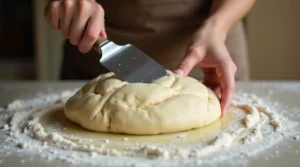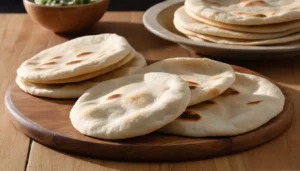Gluten free Syrian bread
Bake perfect gluten free Syrian bread every time with these 6 power tips designed to elevate your bread-making game
Equipment
- measuring cups
- a sturdy mixing bowl.
- Rolling Pin
- Dough Scraper
- Baking Stone
Ingredients
- 1 ½ cups Rice Flour Forms the base of the flour blend providing a neutral flavor and light texture.
- ½ cup Tapioca Starch Adds elasticity and chewiness to mimic the effects of gluten.
- ½ cup Sorghum Flour Enriches the bread with a subtle sweetness and robust flavor.
- 1 tablespoon Psyllium Husk Powder Acts as a binder improving dough structure and moisture retention.
- 2 teaspoons Active Dry Yeast Facilitates the rise and creates airy pockets in the bread.
- 1 teaspoon Sugar Feeds the yeast for proper fermentation.
- ¾ cup Warm Water Hydrates the dough and activates the yeast.
- 2 tablespoons Olive Oil Enhances flavor and creates a soft pliable dough.
- 1 teaspoon Salt Balances flavors and strengthens the dough’s structure.
- 1 clove Garlic Optional: minced Adds a savory note to the bread.
- 1 teaspoon Za’atar Optional: Provides a traditional Middle Eastern flavor profile.
- 1 tablespoon Sesame Seeds Optional: Adds texture and a nutty aroma to the finished bread.
Instructions
Preparing Your Workspace for Baking
- Start by organizing your tools and ingredients. Dust your surface lightly with gluten free flour to prevent sticking, and preheat your oven for even baking. A clean, clutter-free workspace helps streamline the process.

Mixing the Dough: Combining Ingredients Perfectly
- Combine dry ingredients flour, salt, yeast, and binders in a large bowl. Gradually add wet ingredients, starting with warm water and olive oil. Mix until the dough forms a cohesive, sticky ball. Don’t overmix, as overmixing can make the bread too dense.
Kneading Techniques for Gluten Free Dough
- Unlike traditional dough, gluten free dough requires minimal kneading. Use a dough scraper to fold the dough onto itself until it’s smooth and pliable. Lightly oil your hands to handle the sticky texture more easily.

Proofing: Creating the Perfect Environment for Rise
- Place the dough in a warm, draft-free place to rise. Cover the bowl with a damp cloth or plastic wrap to retain moisture. Allow the dough to double in size, which usually takes 1–2 hours depending on the ambient temperature.
Shaping and Rolling Dough for Authentic Syrian Bread
- Split the dough into equal pieces and roll each one into a ball. Roll out each piece on a floured surface to form flat, round discs about ¼ inch thick. Avoid over-flattening, which can compromise the rise.

Baking Techniques: Time, Temperature, and Tools
- Transfer the dough onto a preheated baking stone or tray. Bake at 450°F for 8–10 minutes or until the bread puffs up and develops a light golden color. For a crispier crust, briefly broil the bread after baking.
Post-Bake Care: Cooling and Storing the Bread
- Remove the bread from the oven and let it cool on a wire rack to prevent sogginess. Store in an airtight container at room temperature for up to 2 days or freeze for a longer shelf life. Reheat in the oven or toaster for a fresh-from-the-oven experience.
